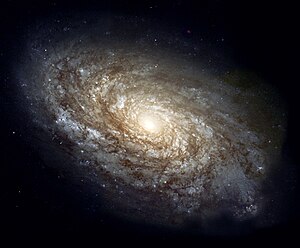NGC 4414
| Galaxie NGC 4414 | |
|---|---|
 | |
| Aufnahme mithilfe des Hubble-Weltraumteleskops | |
| AladinLite | |
| Sternbild | Haar der Berenike |
| Position Äquinoktium: J2000.0, Epoche: J2000.0 | |
| Rektaszension | 12h 26m 27,10s[1] |
| Deklination | +31° 13′ 24,7″[1] |
| Erscheinungsbild | |
| Morphologischer Typ | SA(rs)c? / HII / LINER[1] |
| Helligkeit (visuell) | 10,3 mag[2] |
| Helligkeit (B-Band) | 11,0 mag[2] |
| Winkelausdehnung | 4′,4 × 3′,0[2] |
| Positionswinkel | 155°[2] |
| Flächenhelligkeit | 13,0 mag/arcmin²[2] |
| Physikalische Daten | |
| Zugehörigkeit | NGC 4274-Gruppe LGG 279[1][3] |
| Rotverschiebung | 0,002388 ± 0,000020[1] |
| Radialgeschwindigkeit | (716 ± 6) km/s[1] |
| Hubbledistanz H0 = 73 km/(s • Mpc) | (32 ± 2) · 106 Lj (9,92 ± 0,7) Mpc [1] |
| Durchmesser | 40.000 Lj |
| Geschichte | |
| Entdeckung | Wilhelm Herschel |
| Entdeckungsdatum | 13. März 1785 |
| Katalogbezeichnungen | |
| NGC 4414 • UGC 7539 • PGC 40692 • CGCG 158-108 • MCG +05-29-85 • IRAS 12239+3129 • KUG 1223+315 • 2MASX J12262708+3113247 • GC 2972 • H I 77 • h 1258 • NVSS J122627+311326 • LDCE 867 NED112 | |
NGC 4414 ist eine aktive Spiralgalaxie vom Hubble-Typ Sc mit ausgedehnten Sternentstehungsgebieten im Sternbild Haar der Berenike am Nordsternhimmel. Sie ist schätzungsweise 32 Millionen Lichtjahre von der Milchstraße entfernt und hat einen Durchmesser von etwa 40.000 Lichtjahren. Gemeinsam mit 18 weiteren Galaxien bildet sie die NGC 4274-Gruppe (LGG 279).
Im selben Himmelsareal befinden sich u. a. die Galaxien NGC 4359 und IC 3330.
Mit Hilfe des vom IRAM betriebenen 30-Meter-Radioteleskops auf dem Pico del Veleta in Spanien konnte zum ersten Mal Kohlenmonoxid in den Randgebieten von NGC 4414 nachgewiesen werden; offenbar ist die Galaxie 1,5 Mal so groß wie ihr sichtbarer Teil.[4]
Am 20. April 1974 wurde von W. Burgat die Supernova SN 1974G vom Typ Ia entdeckt.[5][6][7]
Am 7. Juni 2013 entdeckten Fabrizio Ciabattari und Emiliano Mazzoni vom Italian Supernovae Search Project (ISSP) die Supernova SN 2013df vom Typ II.[8]
Das Objekt wurde am 13. März 1785 vom deutsch-britischen Astronomen Wilhelm Herschel entdeckt.[9]
Weblinks
- GoBlack
- The Hubble Space Telescope Key Project on the Extragalactic Distance Scale. XI. The Cepheids in NGC 4414, bibcode:1998ApJ...505..207T
- SIMBAD Astronomical Database
Einzelnachweise
- ↑ a b c d e NASA/IPAC EXTRAGALACTIC DATABASE
- ↑ a b c d e SEDS: NGC 4414
- ↑ VizieR
- ↑ Ute Kehse: Dunkler Wasserstoff entdeckt. In: Wissenschaft.de. 18. November 2004, abgerufen am 8. September 2019 (deutsch).
- ↑ List of Supernovae. HARVARD-SMITHSONIAN CENTER FOR ASTROPHYSICS, abgerufen am 16. September 2008 (englisch).
- ↑ Searching NED for object "SN 1974G*". In: NASA/IPAC Extragalactic Database. Abgerufen am 16. September 2008 (englisch).
- ↑ The Peak Brightness of SN 1974G in NGC 4414 and the Hubble Constant. In: The Astrophysical Journal. 10. Dezember 1998, abgerufen am 14. Juni 2013 (englisch).
- ↑ Simbad
- ↑ Seligman
Auf dieser Seite verwendete Medien
In 1995, the majestic spiral galaxy NGC 4414 was imaged by the Hubble Space Telescope as part of the HST Key Project on the Extragalactic Distance Scale. An international team of astronomers, led by Dr. Wendy Freedman of the Observatories of the Carnegie Institution of Washington, observed this galaxy on 13 different occasions over the course of two months. Images were obtained with Hubble's Wide Field Planetary Camera 2 (WFPC2) through three different color filters. Based on their discovery and careful brightness measurements of variable stars in NGC 4414, the Key Project astronomers were able to make an accurate determination of the distance to the galaxy. The resulting distance to NGC 4414, 19.1 megaparsecs or about 60 million light-years, along with similarly determined distances to other nearby galaxies, contributes to astronomers' overall knowledge of the rate of expansion of the universe. In 1999, the Hubble Heritage Team revisited NGC 4414 and completed its portrait by observing the other half with the same filters as were used in 1995. The end result is a stunning full-color look at the entire dusty spiral galaxy. The new Hubble picture shows that the central regions of this galaxy, as is typical of most spirals, contain primarily older, yellow and red stars. The outer spiral arms are considerably bluer due to ongoing formation of young, blue stars, the brightest of which can be seen individually at the high resolution provided by the Hubble camera. The arms are also very rich in clouds of interstellar dust, seen as dark patches and streaks silhouetted against the starlight.
ID: GPN-2000-000933
Other ID: PR99-25